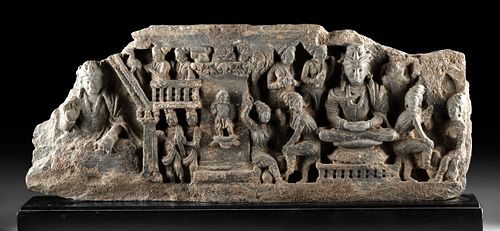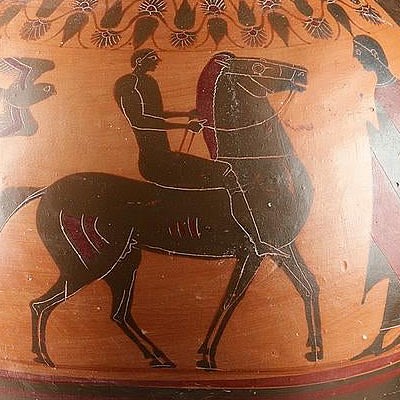Rare Gandharan Schist Frieze - 2 Buddhas, Attendants
Lot 105
About Seller
Artemis Gallery
686 S Taylor Ave, Ste 106
Louisville, CO 80027
United States
Selling antiquities, ancient and ethnographic art online since 1993, Artemis Gallery specializes in Classical Antiquities (Egyptian, Greek, Roman, Near Eastern), Asian, Pre-Columbian, African / Tribal / Oceanographic art. Our extensive inventory includes pottery, stone, metal, wood, glass and textil...Read more
Categories
Estimate:
$10,000 - $18,000
Absentee vs Live bid
Two ways to bid:
- Leave a max absentee bid and the platform will bid on your behalf up to your maximum bid during the live auction.
- Bid live during the auction and your bids will be submitted real-time to the auctioneer.
Bid Increments
| Price | Bid Increment |
|---|---|
| $0 | $25 |
| $300 | $50 |
| $1,000 | $100 |
| $2,000 | $250 |
| $5,000 | $500 |
| $10,000 | $1,000 |
| $20,000 | $2,500 |
| $50,000 | $5,000 |
| $100,000 | $10,000 |
| $200,000 | $20,000 |
About Auction
By Artemis Gallery
Jun 4, 2020
Set Reminder
2020-06-04 10:00:00
2020-06-04 10:00:00
America/New_York
Bidsquare
Bidsquare : Exceptional Antiquities, Asian, Ethnographic
https://www.bidsquare.com/auctions/artemis-gallery/exceptional-antiquities-asian-ethnographic-5185
An important one-day auction featuring museum-worthy examples of Egyptian, Greek, Roman, Etruscan, Near Eastern, Far East / Asian, Pre-Columbian, African / Tribal, Oceanic, Native American, Spanish Colonial, Russian, Fossils, Ancient Jewelry, Fine Art, so much more! Artemis Gallery info@artemisgallery.com
An important one-day auction featuring museum-worthy examples of Egyptian, Greek, Roman, Etruscan, Near Eastern, Far East / Asian, Pre-Columbian, African / Tribal, Oceanic, Native American, Spanish Colonial, Russian, Fossils, Ancient Jewelry, Fine Art, so much more! Artemis Gallery info@artemisgallery.com
- Lot Description
Central Asia, Pakistan and Afghanistan, Gandharan Empire, ca. 200 BCE to 100 CE. A long carved relief stone panel, made of a dark schist whose surface has become glossy in places from age. Ancient artisans carved it to decorate the walls of a temple or palace. It depicts a fabulous scene of seated Buddhas, attendants, and Classically-inspired architectural features. This is one of those ornate carvings where every corner has something new to look at, including a graceful heron perched atop a sloping roof, a Corinthian column, and a thatched roof, as well as eleven unique attendants, each with their own clothing, expressions, and naturalistic poses. Size: 23.75" W x 9.5" H (60.3 cm x 24.1 cm); 11.7" H (29.7 cm) on included custom stand.
Robert Thurman has written, "Buddha images are like Buddhas themselves in a very real sense - as art emanation bodies - because they have the power to transform." The large Buddha on the left wears draped robes and has his hands positioned in the Bhumisparsha mudra, with his right hand over the right knee reaching towards the ground and the palm inward and touching the lotus throne. His left hand lies in his lap with the palm upright. This mudra represents the moment of his awakening, as he defeated the demon Mara, and claimed the earth as his witness to his enlightenment. The other Buddha is at the right end, projecting peace in the Dhyana Mudra. This is a gesture of meditation, with the hands placed in the lap, right hand on left, with fingers full stretched out and palms facing upwards. The Buddha's face is serene, with a naturalistic and warm expression; he wears a skirt and has a crown topped by a detailed ushnisha.
The Gandharan Empire made itself wealthy in part by controlling lucrative trade along the mountain passes between China in the East and the Near East and Mediterranean in the West; a great deal of this wealth went into local patronage of artisans and art. In the first century CE, Buddhism became fashionable amongst Gandharan elites, and the art produced at this time depicting the Buddha are some of the most striking Buddhist images from the past.
Provenance: private New Jersey, USA collection acquired prior some time between 1990-2000; the piece entered the USA in the 1950s and was in storage for decades
All items legal to buy/sell under U.S. Statute covering cultural patrimony Code 2600, CHAPTER 14, and are guaranteed to be as described or your money back.
A Certificate of Authenticity will accompany all winning bids.
We ship worldwide and handle all shipping in-house for your convenience.
#137816The panel is a fragment from a larger sculpture, with losses to the peripheries and light deposits, mainly in the lower profile areas. Many of the figures present are in great condition with well preserved details.Condition
- Shipping Info
-
All shipping is handled in-house for your convenience. Your invoice from Artemis Gallery will include shipping calculation instructions. If in doubt, please inquire BEFORE bidding for estimated shipping costs for individual items.
-
- Buyer's Premium



 EUR
EUR CAD
CAD AUD
AUD GBP
GBP MXN
MXN HKD
HKD CNY
CNY MYR
MYR SEK
SEK SGD
SGD CHF
CHF THB
THB














